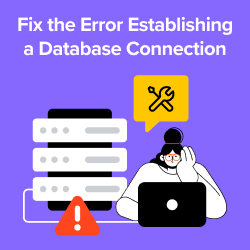wp-config.php to jeden z kluczowych plików WordPress. Zawiera informacje o bazie danych, w tym nazwę, host (zazwyczaj localhost), nazwę użytkownika i hasło. Te informacje pozwalają WordPressowi komunikować się z bazą danych w celu przechowywania i pobierania danych (np. Posty, Użytkownicy, Ustawienia itp.). Plik jest również używany do definiowania zaawansowanych opcji dla WordPressa.
Plik wp-config.php nie znajduje się w domyślnym pakiecie pobierania WordPressa. Zamiast tego zawiera plik o nazwie wp-config-sample.php, który można zmienić nazwę i użyć jako wp-config.php do instalacji i używania WordPressa.
Poniżej pokazano najważniejszą sekcję pliku wp-config:
// ** MySQL settings - You can get this info from your web host ** //
/** The name of the database for WordPress */
define('DB_NAME', 'database_name_here');
/** MySQL database username */
define('DB_USER', 'username_here');
/** MySQL database password */
define('DB_PASSWORD', 'password_here');
/** MySQL hostname */
define('DB_HOST', 'localhost');
Pozostała część pliku wp-config, pokazana poniżej, zawiera również bardziej zaawansowane ustawienia do konfiguracji innych elementów bazy danych, kluczy bezpieczeństwa dla Twojej instalacji WordPressa oraz opcji deweloperskich. Możesz automatycznie wygenerować nowy zestaw kluczy bezpieczeństwa, odwiedzając stronę WordPress API .
/** Database Charset to use in creating database tables. */
define('DB_CHARSET', 'utf8');
/** The Database Collate type. Don't change this if in doubt. */
define('DB_COLLATE', '');
/**#@+
* Authentication Unique Keys and Salts.
*
* Change these to different unique phrases!
* You can generate these using the {@link https://api.wordpress.org/secret-key/1.1/salt/ WordPress.org secret-key service}
* You can change these at any point in time to invalidate all existing cookies. This will force all users to have to log in again.
*
* @since 2.6.0
*/
define('AUTH_KEY', 'put your unique phrase here');
define('SECURE_AUTH_KEY', 'put your unique phrase here');
define('LOGGED_IN_KEY', 'put your unique phrase here');
define('NONCE_KEY', 'put your unique phrase here');
define('AUTH_SALT', 'put your unique phrase here');
define('SECURE_AUTH_SALT', 'put your unique phrase here');
define('LOGGED_IN_SALT', 'put your unique phrase here');
define('NONCE_SALT', 'put your unique phrase here');
/**#@-*/
/**
* WordPress Database Table prefix.
*
* You can have multiple installations in one database if you give each a unique
* prefix. Only numbers, letters, and underscores please!
*/
$table_prefix = 'wp_';
/**
* WordPress Localized Language, defaults to English.
*
* Change this to localize WordPress. A corresponding MO file for the chosen
* language must be installed to wp-content/languages. For example, install
* de_DE.mo to wp-content/languages and set WPLANG to 'de_DE' to enable German
* language support.
*/
define('WPLANG', '');
/**
* For developers: WordPress debugging mode.
*
* Change this to true to enable the display of notices during development.
* It is strongly recommended that plugin and theme developers use WP_DEBUG
* in their development environments.
*/
define('WP_DEBUG', false);
/* That's all, stop editing! Happy blogging. */
/** Absolute path to the WordPress directory. */
if ( !defined('ABSPATH') )
define('ABSPATH', dirname(__FILE__) . '/');
/** Sets up WordPress vars and included files. */
require_once(ABSPATH . 'wp-settings.php');




